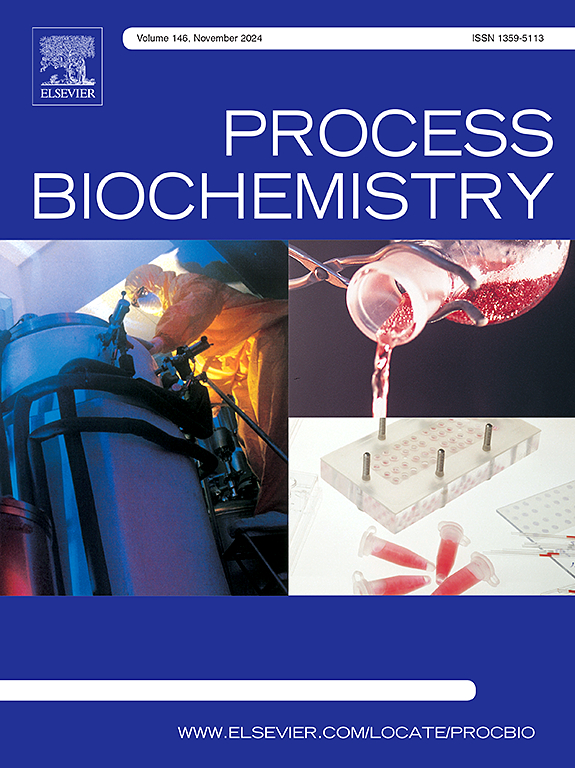Cellulase immobilization within zeolitic imidazolate frameworks by in situ encapsulation
IF 3.7
3区 生物学
Q2 BIOCHEMISTRY & MOLECULAR BIOLOGY
引用次数: 0
Abstract
The industrial applications of cellulase are often restricted by its high cost and poor stability under extreme conditions. In this study, cellulase was immobilized using zeolitic imidazolate framework-8 (ZIF-8) through a one-pot encapsulation method, resulting in the formation of cellulase@ZIF-8 composite designed to address these challenges. The effects of varying Zn²⁺/2-methylimidazole molar ratios and different amounts of cellulase on the properties of cellulase@ZIF-8 were systematically investigated. Cellulase was found to act as a nucleation site, accelerating the formation of cellulase@ZIF-8 while promoting controlled crystal growth. At lower Zn²⁺/2-methylimidazole ratios, cross-shaped cellulase@ZIF-8 crystals with moderate enzymatic performance were obtained. Conversely, at higher Zn²⁺/2-methylimidazole ratios, the resulting spindle-shaped cellulase@ZIF-8 crystals exhibited superior enzyme activity of 327.8 U/g, and a relative activity of 88.6 %. Furthermore, this composite demonstrates excellent thermal and storage stability. The immobilized enzyme retained 92.8 % of its activity at a temperature of 70 °C. Additionally, it maintained 69.8 % of its relative enzymatic activity after undergoing five cycles. These findings have significant implications for the future application of cellulase@ZIF-8 composites in efficient and cost-effective lignocellulosic bioconversion.
原位包封法固定化咪唑沸石框架内的纤维素酶
纤维素酶的工业应用往往受到其高成本和在极端条件下稳定性差的限制。在本研究中,通过一锅包封法使用沸石咪唑酸框架-8 (ZIF-8)固定化纤维素酶,从而形成cellulase@ZIF-8复合材料,旨在解决这些挑战。系统地研究了不同Zn 2 + /2-甲基咪唑摩尔比和不同纤维素酶用量对cellulase@ZIF-8性能的影响。纤维素酶被发现作为成核位点,加速cellulase@ZIF-8的形成,同时促进控制晶体的生长。在较低的Zn 2 + /2-甲基咪唑比下,可以得到具有中等酶促性能的十字形cellulase@ZIF-8晶体。相反,在较高的Zn 2 + /2-甲基咪唑比例下,所得纺锤形cellulase@ZIF-8晶体的酶活性为327.8 U/g,相对活性为88.6% %。此外,该复合材料表现出优异的热稳定性和储存稳定性。在70℃条件下,固定化酶的活性保持率为92.8 %。此外,经过5个循环后,它的相对酶活性保持在69.8 %。这些发现对cellulase@ZIF-8复合材料在高效和经济的木质纤维素生物转化中的未来应用具有重要意义。
本文章由计算机程序翻译,如有差异,请以英文原文为准。
求助全文
约1分钟内获得全文
求助全文
来源期刊

Process Biochemistry
生物-工程:化工
CiteScore
8.30
自引率
4.50%
发文量
374
审稿时长
53 days
期刊介绍:
Process Biochemistry is an application-orientated research journal devoted to reporting advances with originality and novelty, in the science and technology of the processes involving bioactive molecules and living organisms. These processes concern the production of useful metabolites or materials, or the removal of toxic compounds using tools and methods of current biology and engineering. Its main areas of interest include novel bioprocesses and enabling technologies (such as nanobiotechnology, tissue engineering, directed evolution, metabolic engineering, systems biology, and synthetic biology) applicable in food (nutraceutical), healthcare (medical, pharmaceutical, cosmetic), energy (biofuels), environmental, and biorefinery industries and their underlying biological and engineering principles.
 求助内容:
求助内容: 应助结果提醒方式:
应助结果提醒方式:


